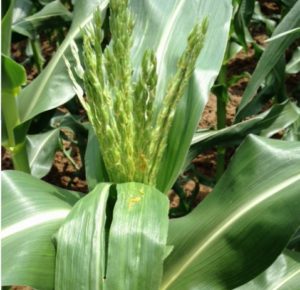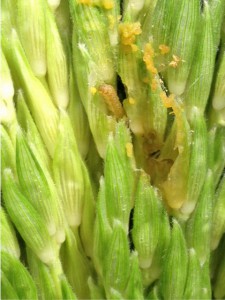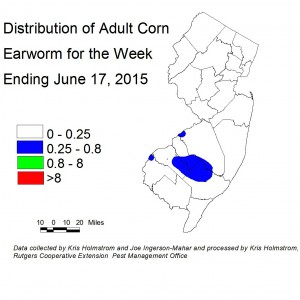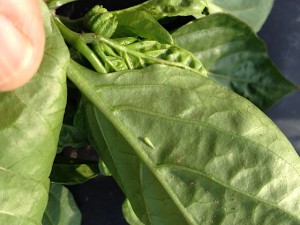Sweet Corn
Warmer evening temperatures have resulted in a slight resurgence of European corn borer (ECB) adults in the blacklight network. A residual first generation population remains in northern NJ, while the activity in the southwestern part of the state may represent the beginning of a second flight. The nature of the southern NJ activity should become clear over the next 1-2 weeks. Areas of highest activity include parts of Morris and Gloucester counties (see ECB map). ECB infestations continue to rise in sweet corn plantings. Feeding ranges from single digits to over 50% in areas where IPM personnel are operating.
Be sure to begin monitoring plantings for ECB feeding while they are still in the whorl stage. Consider treating when the number of infested plants in a 50 plant sample exceeds 12%. Feeding in the whorl stage will appear as numerous small holes (called “shot-hole”) on leaves, with damage present on consecutively younger leaves.
As plants progress to pre-tassel and beyond, the actual larvae may be found in or on the emerging tassels (see photos). Any planting remaining at or above threshold as it proceeds to full tassel should be treated, as this is the last stage at which ECB larvae will be exposed and vulnerable to insecticidal sprays.
-
Sweet corn emerging tassel.
Photo: Kris Holmstrom
-
Sweet corn tassel with ECB larvae.
Photo: Kris Holmstrom
Often, early sweet corn plantings suffer from “split set”, in which germination does not occur in a uniform fashion. The result is a planting where all plants do not reach full tassel at the same time. This situation may require an extra tassel spray if there are several days difference in the time full tassel is reached on a significant number of the plants.
Insecticides that are acceptable in organic production include the spinosyn based material Entrust (IRAC-5) and Dipel (IRAC-11a). The 10G formulation of Dipel is particularly useful when granules can be dropped or broadcast such that they get into the whorls of corn plants. See the 2015 Commercial Vegetable Recommendations Guide for more insecticide choices.
For more information see:
| The highest nightly ECB catches for the previous week are as follows: | ||
| Denville 4 | Belvidere 1 | Pedricktown 1 |
| Beckett 2 | Downer 1 | Port Colden 1 |
| Sparta 2 | Eldora 1 | Tabernacle 1 |
| Allamuchy 1 | Morristown 1 | Woodstown 1 |
- Click to View
- Click to View
There has been a slight increase in catches of corn earworm moths (CEW) in blacklights this past week. This adult activity is primarily focused near the Atlantic-Camden-Gloucester County border, with light catches elsewhere in southern NJ (see CEW Map).
| The highest nightly CEW blacklight trap catches for the previous week are as follows: | ||
| Cinnaminson 1 | Elm 1 | Pedricktown 1 |
| Downer 1 | Folsom 1 | Woodstown 1 |
| The highest nightly CEW pheromone trap catches for the previous week are as follows: | ||
| Springdale 4 | East Vineland 1 | Woodstown 1 |
| Beckett 1 | Green Creek 1 | |
For sinking sweet corn, the following spray schedules are warranted.
Silking Spray Schedules*:
South – 5 days
Central – 6-7 days
North – 6-7 days
Peppers
Young pepper plants are at risk of infestation from this first ECB generation. Be sure to scout fields regularly for the presence of ECB egg masses. If two or more egg masses are found in a 50 plant (two leaves/plant) sample, consider treating even if no fruit are present. In the absence of fruit, ECB larvae will bore into the central stem, topping the plant. This will result in the loss of crown fruit on infested plants. Generally, where blacklight trap catches average one or more ECB per night (blue and green areas on the ECB map) and fruit are greater than ½” in diameter, insecticides are warranted. See the 2015 Commercial Vegetable Production Recommendations for materials useful in controlling ECB.
Pepper Weevil Report
Once again, no pepper weevils have been caught in any trap near a produce handling facility or field borders in the past week. Weevil populations that appear in the traps in May and June lead to field populations in July thru September. If we can get past June without catching weevils, we may have very few, if any infested fields in late summer. There is no map because no weevils were trapped.
Snap Beans
Potato leafhopper (PLH) adults have appeared in snap beans in the northern and central counties this week, and should be considered present in all areas. This pest is a particular problem because it often goes unnoticed until foliar distortion and burn occurs. Once this damage appears, yields have already been compromised. It is critical that beans be monitored regularly for the presence of PLH. If a sweep net is available, consider treating if more than 100 nymphs and adults are present in 20 sweeps of pre-bloom stage plants. This threshold increases to 250 during bloom and to 500 per 20 sweeps during pod development. If no sweep net is available, check plants in 10 random field locations and consider treating if adults and nymphs are found throughout. Adults are pale green (see photo), and will fly out from foliage when disturbed and immediately fly back into the plant canopy. Nymphs are wingless and bright green and may be found on the underside of leaves.
Brown Marmorated Stink Bug (BMSB)
Low numbers of BMSB were captured in NJ blacklight traps this past week. These catches, while too low to create a map, are significant in that more sites are involved, and several have caught multiple individuals per night. The highest nightly CEW pheromone trap catches for the previous week are as follows:
| Cinnaminson 3 | Cedarville 1 | Morristown 1 |
| Pedricktown 3 | Downer 1 | Old Bridge 1 |
| Green Creek 2 | Eldora 1 | Phillipsburg 1 |
| Woodstown 2 | Folsom 1 | Tabernacle 1 |
Tomatoes
Recent rains have resulted in the appearance of bacterial leaf spot (BLS) in several northern NJ tomato plantings. BLS appears as small, very dark lesions on young and older leaves, often causing some distortion where leaves were not fully expanded when the infection started (see photo). It is important to treat preventively for bacterial infections. Timing and rates for applications of copper and/or the plant defense activator Actigard are detailed in the 2015 Commercial Vegetable Production Recommendations. These products provide some suppression of bacterial pathogens. Pruning and tying of plants is on-going. Remember that any event that results in contact with the plant causes numerous injuries to them (this includes hail injury). While these injuries heal, they serve as avenues of entry for bacterial pathogens that may be present either on the plants or in the field. BLS can result in unmarketable fruit. It is critical that spread of bacterial organisms be limited as much as possible. Avoid working in fields when plants are wet. When work is to be done in more than one planting, always work from youngest to oldest plants. This prevents workers from transporting bacteria to younger plants, where infections can result in increased crop loss. Remember that the earlier a plant is infected by a bacterial pathogen, the more likely it is to produce unmarketable fruit.
Pumpkins and Winter Squash
These crops are now emerging in many areas. It is important to monitor frequently for the presence of striped cucumber beetles at this time, particularly if the seed was not purchased pre-treated with an insecticide for cucumber beetle. Check 5 consecutive plants each in 10 random locations. Examine upper and lower surface of seed leaves for the presence of beetles. Consider treating if beetles are found at 5 or more sites. Heavy, but local infestations may be spot treated. Management of these pests will limit the loss of plants to the bacterial wilt disease that the beetles transmit.
A sentinel plot containing susceptible and resistant cucumber varieties, as well as muskmelons, watermelons, acorn and butternut squash and pumpkins is now established at the Snyder Research and Extension Farm in Hunterdon County. The purpose of this plots is to detect the presence of downy mildew (DM) in northern NJ. Any occurrence will be reported in this newsletter and will also generate an alert to all subscribers. For more information on the regional presence of DM as well as comprehensive, weekly forecasts, see the following website: http://cdm.ipmpipe.org/







